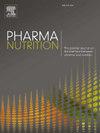Flavonoids and macrophage polarization: Key players in the immunomodulation of cardiometabolic syndrome and related therapies
IF 2.4
Q3 NUTRITION & DIETETICS
引用次数: 0
Abstract
Cardiometabolic syndrome (CMS) is a major public health challenge characterized by obesity, insulin resistance, hypertension, and chronic inflammation, which increase the risk of type 2 diabetes (T2D) and cardiovascular disease. In this context, inflammatory M1 macrophages are pivotal, as they produce proinflammatory cytokines and contribute to oxidative stress, insulin resistance, and lipid accumulation in adipose tissue. Polyphenols with anti-inflammatory, antioxidant, and antiobesity properties alleviate CMS by promoting M2 macrophage differentiation and reprogramming M1 macrophages toward the M2 phenotype. Flavonoids inhibit inflammatory pathways such as NF-kB and activator protein-1 (AP-1); reduce the expression of proinflammatory markers such as TLR4, NOD-like receptor family pyrin domain-containing 3 (NLRP-3), and inducible nitric oxide synthase (iNOS); and enhance anti-inflammatory responses, including IL-10, Nrf-1, and peroxisome proliferator-activated receptor (PPAR) expression. They prevent foam cell formation by decreasing LPX-1, CD36, scavenger receptor-A, B1, and LOX-1 expression while increasing ABCA1 and ABCG1 levels. Flavonoids are antiobesity agents that decrease the infiltration of macrophages in adipose tissue and suppress the M1 phenotype in adipose tissue macrophages, lowering inflammation and leading to the suppression of lipogenesis and stimulation of lipolysis in adipocytes. This review highlights the importance of macrophage activation in metabolic imbalance and the potential of flavonoids in treating CMS through the induction of M2 macrophages.
黄酮类化合物和巨噬细胞极化:心脏代谢综合征免疫调节和相关治疗的关键参与者
心血管代谢综合征(CMS)是一个主要的公共卫生挑战,其特征是肥胖、胰岛素抵抗、高血压和慢性炎症,增加了2型糖尿病(T2D)和心血管疾病的风险。在这种情况下,炎性M1巨噬细胞是关键,因为它们产生促炎细胞因子,并有助于氧化应激、胰岛素抵抗和脂肪组织中的脂质积累。具有抗炎、抗氧化和抗肥胖特性的多酚通过促进M2巨噬细胞分化和将M1巨噬细胞重编程为M2表型来缓解CMS。黄酮类化合物抑制NF-kB和激活蛋白-1 (AP-1)等炎症通路;降低促炎标志物TLR4、nod样受体家族pyrin - domain-containing 3 (NLRP-3)、诱导型一氧化氮合酶(iNOS)的表达;并增强抗炎反应,包括IL-10、Nrf-1和过氧化物酶体增殖物激活受体(PPAR)的表达。它们通过降低LPX-1、CD36、清扫剂受体a、B1和LOX-1的表达,同时增加ABCA1和ABCG1的水平,从而阻止泡沫细胞的形成。类黄酮是一种抗肥胖药物,可减少脂肪组织中巨噬细胞的浸润,抑制脂肪组织巨噬细胞的M1表型,降低炎症,抑制脂肪细胞的脂肪生成和刺激脂肪分解。本文综述了巨噬细胞激活在代谢失衡中的重要性,以及黄酮类化合物通过诱导M2巨噬细胞治疗CMS的潜力。
本文章由计算机程序翻译,如有差异,请以英文原文为准。
求助全文
约1分钟内获得全文
求助全文
来源期刊

PharmaNutrition
Agricultural and Biological Sciences-Food Science
CiteScore
5.70
自引率
3.10%
发文量
33
审稿时长
12 days
 求助内容:
求助内容: 应助结果提醒方式:
应助结果提醒方式:


